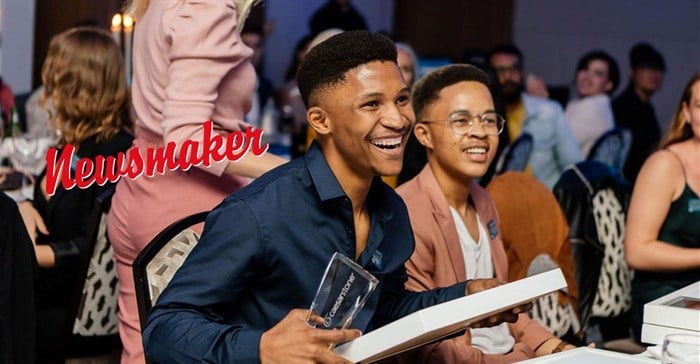Hailing from Alexandra in Johannesburg, Kgothatso John Malange is a design force to be reckoned with and was recently announced as the official winner of the Caesarstone Student Designer of 2019, placing him in the ranking as South Africa's most promising designer.

Kgothatso John Malange was recently announced as the official winner of the Caesarstone Student Designer of 2019. Image supplied.
Supported by design heavyweights and announced before SA's acclaimed design industry, Kgothatso's life has been forever changed and there is not a more deserving winner. Having never left South Africa, Malange and his lecturer will be flown to the international design fair of his choice on an all-expenses-paid trip and exposed to the world’s greatest design minds.
Here, he speaks about what this opportunity means to him and explains how creativity can empower our cultural and creative industries and Africa’s economy as a whole.
What does this recognition and opportunity mean to you?
This opportunity means a lot as it is one of the most massive stepping stones towards my design career and can create countless opportunities for me and other upcoming designers.
The recognition means that I can inspire many young creative designers like myself to keep on pushing for a better future. Never stop doing what you love.
 Comment on this year’s brief and how you believe creativity or architecture/interior design can empower our cultural and creative industries and the African economy?
Comment on this year’s brief and how you believe creativity or architecture/interior design can empower our cultural and creative industries and the African economy?This year’s brief was an exciting one as I got a chance to think and come up with solutions that architects usually do. As interior designers, we focus more on the interior space, but with this brief, it forced other design students and me to focus on both exterior and interior.
With our creativity comes new investors. With our unique solutions comes a better world to live in.
The more we create a functional living environment, the more people want to live and spend time in it, and that becomes a culture that creates jobs and betters Africa's economy.Tell us about the work you submitted, and what you think made it stand out from the rest.
The submitted project not only deals with what the client wants, but it also deals with local problems. As designers, we are the ones that are responsible for coming up with solutions that will benefit the locals. It should also be fun, exciting and address real-life crises.
I focused on the fun side of the design and the local needs. Cape Town has problems with water shortages. I took that into account and came up with the solution of incorporating what we call a problem as a design solution.
What made my project stand out is the simplicity of my presentation board layout, from the first board just explaining the concept used and showing the site, the exterior of the building and the floor plans.
The way I told my story, if we look at the second board, showing the section and the movement in it, from the ground floor to the mezzanine level. The main view of the second board is the cafe that looks onto the two VR experience sections, the one on the ground and the other on the mezzanine level.The cafe position is to invite people to the open VR experience and entertain them at the same time. The final board focuses more on the answering of the brief, the views found in the last board are that of the consultant area, point-of-sale gaming rooms, and the open VR experience room view on the mezzanine level.
With the main picture on the last board, I made sure that it does not show one valuable space but many useful areas that go hand-in-hand with what the brief wanted. The picture shows the display area, the position of the point of sale and the primary and essential view of the Open 360 VR experience room/dome.
Why did you decide to study interior design, and at the Tshwane University of Technology specifically?
From drawing Dragon Ball Z characters, I decided to study design when I was in Grade 3, but the thing was I did not know the term architecture or interior design. Back in Grade 3, girls in my class would ask me to draw kitchens for their paper dolls, and every time they would come back for more drawings as they were happy with the previous work, and yes, they paid me R5 per drawing.
The other reason is that as I was growing up, shows like Extreme Makeover made it easy for me to study design because looking at them creating solutions for people in need made me want to be part of the solution creators, and that’s when I knew I wanted to design for a living.
I went to TUT to study interior design because my friend informed me about the university being the best institution when it comes to design. I did my research and decided to go and now I am thankful for making that decision.
Tell us about your lecturer Rene van der Merwe, and the most notable thing she taught you.
Rene van der Merwe is easy to work with and she lets you design what you think and feel is right. One thing she told me is that I am a designer, a designer that needs to think about the other person, the person who is going to be in the space I design. That person needs to feel comfortable. For that person, I must create a space that will bring exciting experiences, and when designing, a designer needs to always follow the brief.
What are you most looking forward to?
I am looking forward to a better future for myself, my family and my design family. Meeting more people who understand my design creativity — working with inspiring individuals, creating a culture that will benefit the world and the people in it.
What advice would you give to aspiring students in the creative industry?
Design for your client, not for you; read and follow the brief. Don’t feel left out, put your personality in your design, as your design will speak for you when you are not there. In the design world, never doubt yourself, do what you love and don’t let your soul become a victim of anxiety; your creativity is the world's next solution.
For more information on this competition, visit the Caesarstone website, and for more on Malange and his work, follow him on Instagram.

































 Comment on this year’s brief and how you believe creativity or architecture/interior design can empower our cultural and creative industries and the African economy?
Comment on this year’s brief and how you believe creativity or architecture/interior design can empower our cultural and creative industries and the African economy?

